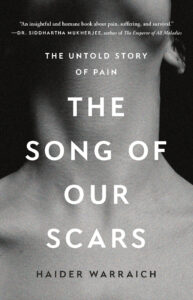What Does It Mean to Understand Pain?
Haider Warraich Considers the Complexity and Meanings of Chronic Pain
Pain is sensitive to context in a way no other human sensation is. The aches that engulf a marathoner’s entire body change meaning instantly when that marathoner crosses the finish line. During sex, pain can induce euphoria or leave lifelong scars. The pain in the belly that the devout believer feels during a religious fast is very different from that felt by someone starving because they cannot afford a meal. While some variation in pain sensitivity between individuals occurs due to biological differences, our response to pain is largely mediated by the surrounding circumstances we feel it in. In fact, even the genes that cause us to feel pain are deeply affected by the environments we grow up in.
We have been trying to understand the complexities of pain as long as we have been around. In Book 9 of The Republic, Socrates, speaking to his brother Glaucon, asks, “Do we not say that pain is opposite to pleasure?” To Socrates, pain was not merely the absence of pleasure; it was based on where a person started from: Did they move from pleasure to pain or simply from the tranquil middle? An individual’s baseline sets up the subsequent experience of either pain or pleasure, which Socrates considered to be on the opposite ends of a spectrum. Moving from pleasure to pain, according to this dictum, is more distressing than moving from pain to more pain. Are we any closer to understanding pain today?
The expression people in pain most dread hearing is that their agony is “all in their head.” It is often used to diminish that agony, to erase their very personhood. Yet our brain does have a central role in shaping how we hurt. After a pain signal reaches the brain, it undergoes significant reprocessing. The brain, based on previous experiences and current expectations, can modulate pain to be felt either more or less severely. How much something hurts can vary depending on factors like one’s mood and level of distraction. The human brain is not just staffing the ticketing booth at the circus— it is the ringleader. Without the brain’s permission, no tigers jump through burning hoops, no trapeze artists fly around, no swords are swallowed.
The brain is particularly involved in the experience of chronic pain. Most people assume that when pain lasts long enough, usually more than three months, it transforms into chronic pain. This is how people like me who live with pain have come to think of it and how doctors also like me have been trained to treat it: chronic pain is essentially acute pain prolonged. Yet, if you dive deep into the science only now emerging, a very different picture comes together: acute and chronic pain are entirely distinct phenomena, and there is no justification for treating them the same way.
Recognizing the many layers of pain and how we respond to the agony of others could lay the foundation for a just and equitable society.The siloed nature of science means that at present there is no single working theory for what chronic pain is. Yet my journey poring over thousands of research studies and speaking to dozens of experts and patients, as well as my own odyssey aboard this faltering body, makes one thing clear: most chronic pain is not just a physical sensation. To our nervous system, chronic pain is most often akin to an emotion we feel in a part of our body, an overlearned traumatic memory that keeps ricocheting around in our brains, often long after the injury it rehearses has fully healed. Unlike acute pain, which ascends up the spinal cord to the brain from a nick on the shin or a frayed nerve in the foot, chronic pain descends down from the brain, often with no need for an incitement from below.
Pain remains a difficult matter to approach primarily because of the gulf between the people who experience it, the clinicians who treat it, and the researchers who study it. This gulf means that many common notions are about as grounded in reality as magical fairy dust. It is said that what doesn’t kill you makes you stronger. Yet research actually suggests the opposite, that people who have chronic pain are even more sensitive to pain than those for whom pain is a stop but not a terminal destination. It is said that pain is inevitable but suffering is optional. Yet I cannot imagine that anyone who has experienced persistent pain personally or cared for someone in unflagging agony would ever believe such hogwash. When pain arrives and refuses to leave, suffering is as inevitable as death itself. The only thing I have gained from pain is the lived experience so essential to knowing how ceaseless suffering can wring a human spirit dry.
Standing on this island, I feel pain coming at me from all directions. It comes to me from within when I wake up in the middle of the night in affliction. It comes to me from my patients, who often have disease eating their insides out, leaving them up to their nostrils in pain. And it has come to me from the papers, books, and articles I have read and the scientists, clinicians, and patients I have spoken to about all that hurts.
To understand pain is to know the human body and the human mind and how they are interweaved. It is the strongest riposte to how clinical medicine artificially divides them.
To understand pain is to recognize how race, gender, ethnicity, and power come to indelibly mark what it means to inhabit the human frame.
To understand pain is to learn how the greatest medical tragedy in history came to be, how corporate greed and academic naivete and corruption fueled the opioid epidemic, and how it could recur again.
To understand pain is to explore the true nature of human suffering, how religion and spirituality have often been our most potent balms, and how movements such as existentialism, feminism, and consumerism have changed not only our core beliefs but also our senses.
Yet the need to understand pain is not just a scientific curiosity for me. It has given deeper meaning to the pain that I feel. And while this knowledge may not always grant me complete relief, it has allowed me to find a new way to live in my body.
Broadening the lens through which I see pain has helped to defog the window through which I see the pain of others, an essential part of my work as a clinician. Even as physicians and nurses are almost constantly face-to-face with suffering, that existential leap known as empathy, the act of feeling another’s pain, is especially important as we increasingly rely on blood tests and imaging to tell us what ails a patient, while pain continues to elude such quantification. Relieving pain is one of the most gratifying feelings a clinician can ever get in the course of their vocation.
Yet the drive to label pain as a physical sensation, as a vital sign similar to heart rate or blood pressure, was not an organic movement founded by clinicians. It was in fact engineered by the pharmaceutical industry, appealing to clinicians’ deep desire to relieve suffering to sell trillions of dollars’ worth of products. And while the drugs and devices they sold provided comfort in the short term, for people with chronic pain they were ineffective for most and deadly for many.
If you twist your ankle or bump your head, or if you live with torment that never ebbs, what you feel and how you respond is not just the aggregate of nerve signals bombarding your brain stem. It is the sum product of your entire existence and the entire history of human beings encapsulated in the multidimensional experience we call pain.
Reaching a new understanding of how we hurt will change how we live with our aching selves. Synthesizing our knowledge about the fundamentals of pain could move us closer to a future in which even if we hurt, we don’t suffer. And recognizing the many layers of pain and how we respond to the agony of others could lay the foundation for a just and equitable society.
________________________________

Excerpted from The Song of Our Scars: The Untold Story of Pain by Haider Warraich. Copyright © 2022. Available from Basic Books, an imprint of Hachette Book Group, Inc.




















